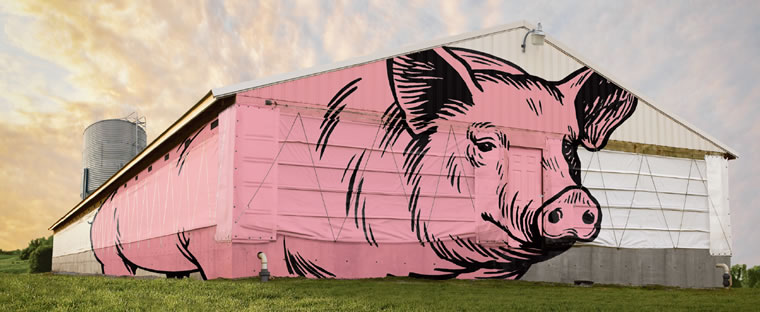
When entering the barn, make an overall assessment of barn environment.
- Pay attention to the pigs’ sleeping habits. If possible enter the barn or room quietly so as not to disturb them. Pigs normally lay on
their side with their backs to the wall, gate, feeder or the pig next to them. Pigs that pile on top of each other or lay with their legs tucked under them are indicating that they are chilled or sick.
- Evaluate the temperature, at pigs’ level, not at your level. you read temperature sensors or room thermometers, be sure to adjust
for their distance from the floor.
- air quality. High humidity may show up as condensation on ceilings, floors, waterlines or air inlets. Ammonia will cause irritation to your eyes and nose.
- Listen for coughing and sneezing, especially shortly after you enter the barn.

Approach each pen as an individual unit of animals.
- As you approach the pen there should be a variety of activities in the pen depending on the time of day. Normally you should expect to see some pigs eating and some pigs drinking, but there should be few pigs fighting for either of these activities. Most pigs should readily rise and move about the pen when you approach or enter the pen.
- Pigs should be moving around the pen at about the same pace. Pigs getting trampled or pushed to the side are likely under some kind of disease pressure.
- Make sure feed is available. Feeders may need to be adjusted frequently to allow proper flow.
- sure cup waterers have water in them or that nipple waterers have signs of water beneath them on the slats.
Nipple waterers should be at the top of the pigs’ shoulders so that all pigs can reach them.
- Look for loose stools.
- for items in need of repair (gates, feeders, etc.) that may injure pigs

Look at each pig from nose to tail and head to toe.
- Nose–should be moist but no discharge, pink but not red.
- Eyes–should be bright and alert with little or no discharge.
- Ears–should normally be erect and upright. (Landrace and some other breeds may show a tendency to droop down over the eyes. This may cause some difficulties in assessment.) Ears should be pink, not red or purple.
- Breathing–should be smooth and effortless. Panting may be normal during periods of high room temperature but thumping (hard abdominal breathing) and labored breathing are indications of respiratory disease.
- Body fill should show some signs of feed consumption in the flank area. Gauntness or thinning behind the rib cage indicates that the pig has not eaten for 24 hours or more.
- Posture–pig should appear comfortable when laying, sitting or standing.
- Tail–manure staining in the tail area may be an early sign of diarrhea.
- Hair coat–should be smooth and somewhat shiny. Rough hair may be a sign of chilling or general depression.
- Legs and feet–pig should be able to move freely about the pen. Feet and joints should not be swollen.

After identifying situations and animals needing attention, take action.
Make appropriate changes to ventilation, feed or water systems as outlined in your barn protocols. Consult your supervisor or veterinarian as needed to determine the best course of action.

Product Information contained on this page applies to the United States only.
For other countries please refer to your local representatives.



 DRAXXIN
DRAXXIN Health and Performance Improvements of Pigs Treated with DRAXXIN® (tulathromycin) Injectable Solution for Swine Respiratory Disease Under Field Conditions
Health and Performance Improvements of Pigs Treated with DRAXXIN® (tulathromycin) Injectable Solution for Swine Respiratory Disease Under Field Conditions Product Information contained on this page applies to the United States only.
Product Information contained on this page applies to the United States only.










